
In Conversation With Me
There have been many times when someone in my family has caught me. My facial expressions give me away, along with that middle-distance look I get. They want to know what I am discussing with myself. I will never say. Those are my private thoughts oozing out through my face and it’s nobody’s business.
Of course, I’m just talking to myself.
It happens when my sub-vocalized storyteller takes over and I’m making a strong expository point or actually arguing both sides of … something.
People who talk to themselves have always faced a certain stigma. The guy who walks down the street talking into an invisible earbud-based phone gives me the creeps. I don’t want to hear his half of whatever conversation cannot wait until such time as he is in a less public place. That annoying guy is not actually talking to himself, though. It just looks that way.
Really talking to yourself is engaging in a debate so familiar to you that you can easily argue both sides. Add purpose, character, humour, emotion and you have a dialogue. A genuine dialogue between people whose goals are different is the heart of a conflict that can drive a narrative.
That means learning to talk to yourself using different points of view is the essence of creative storytelling. You let your characters do the writing and spill the conflict out on the page and ignore all the clever descriptions of facial ticks and chewed fingernails. Put those in later when you know they won’t get in the way. They will help add hue to the colour the dialogue establishes.
I would argue, then, that I am not weird. Or, at least I am not weird for that reason.
Talking to myself is something I have to do.
And, like a lot of other things, better out than in.
